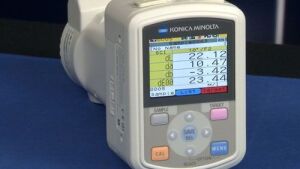Photo spectrometer
Fotospektrometer
Image: T. VoigtPhoto spectrometer
Portable digital photospectrometers measure non-destructive, precise, high-resolution (spectral resolution of 3-8 nm) and repeatable reflected light (400-700 nm) on surfaces. Results are shown numerically or graphically on a display as spectra, can be transferred to computers (USB, Bluetooth) and quantitatively processed there (color difference, contrast, etc.). The advantage over geochemical analyses and petrographic investigations is the speed of measurement (a few seconds) and the low cost, which allows high spatial resolution (centimeters to millimeters) and the recording of even large sediment thicknesses.
The high sensitivity makes the use of such an instrument especially suitable where the human eye sees only few or unsystematic color changes, e.g. in the fine recording of fine-grained rocks, drill cores, underground or in the empirical description of color hues and intensities within mineral-specific mixed series (Fe, Ni, Cr, Mn, Cu etc.).
Among others, we use this instrument as follows:
for the analysis of Tertiary lake drill cores in South Kazakhstan for the reconstruction of climate evolution in Central Asia (planned DFG project Voigt, Frenzel)
for the analysis of cores of the ICDP project "Archean surface environments" (Heubeck)
for upscaling of information obtained e.g. by the µ-XRF scanner on drill core slices to the dm- to m-scale (Heubeck, Pudlo, Kukowski)
for spectral imaging of the core of the Erfurt borehole (Triassic) to determine cyclic variations in depositional conditions (Bachelor and Master theses)
for the color characterization of Thuringian sandstones, e.g. for the determination of the origin of the work stones in Romanesque sacred buildings and as a recommendation for the preservation of monuments (joint project of the Institute for Stone Conservation Mainz and the IGW of the University of Jena; Voigt)
